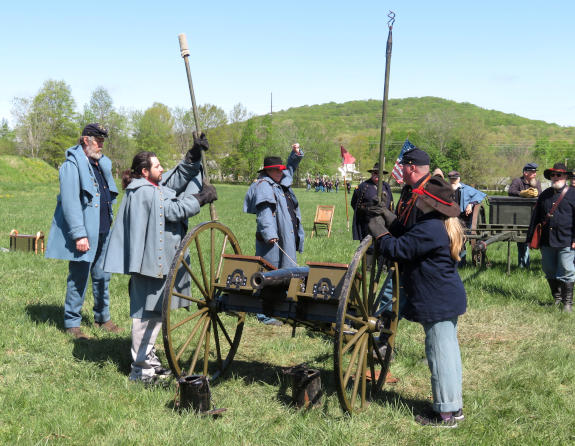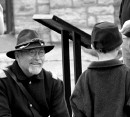NEWS OF 150 YEARS AGO
May 1861
AT THE ARSENAL.―One of the busiest and most suggestive scenes in the country, and one which can scarcely ever fade from the mind of the thoughtful spectator, is that to be witnessed each day within the walls of the St. Louis Arsenal. Nature and art appear to have consecrated the spot to peace rather than designed it as a battle ground. A broad and verdant plane [sic] beautifully rising from the river, lavishly adorned with thick clusters of shade trees, and tastefully laid out in quiet walks, it is not only no fort but scarcely a site for a fortress. Its residences and gardens, workshops, and buildings for the storage of munitions of war, are disposed on the lower part of the slope, near the river, with little further defences than the ingenuity and energy of the present commandant has created. The encompassing wall might prove even an injury to the defenders, and would probably have at once to be destroyed by their own cannon in case of an attack. The entire scene is appropriately a peaceful and beautiful one, and especially so at this season of the year, when the extensive areas of sward are green, and the overreaching trees are in luxuriant leaf, and the air and the sunshine are so fresh and genial. A bird may occasionally be seen hopping timidly among the highest branches, but doubtless many a nest has been forsaken since the conversion of the grounds into a camp and fortress.
That Arsenal Camp is no holiday muster appears from the long lines of un-uniformed militia, and the persistency and severity of the drill to which they are subjected. Everywhere the visitor perceives a squad, or company, or battalion or regiment, each under a separate drill master, desperately performing maneuvers that appear endless and are mysterious to the uninitiated spectator. On all hands resound the cries of martial command, the measured tramp of columns, the time call of fife and drum, the discharge of musketry, and many strains and styles of merriment from throngs of strolling visitors―juvenile, feminine and virile―and from whole companies of recruits reposing on the grass. At the quarters may be witnessed enormous culinary demonstrations―acres, apparently covered with steaming camp kettles, coffee boilers and immense soup pots. Here are heroes laboriously roasting coffee, othere perspiringly grinding it, others rinsing and arranging a multitudinous display of tin pans and cups, knives, forks and spoons, while others are in great travail about the fires, splitting wood, or vigorously plying frying pans, pokers and ladles. Wondering housewives frequent these parts and gaze upon the sights with evidently amused and critical eye.
One would fain inquire “Where do the troops all dine?” but a moment’s further survey indicates that each simply gets his pot and pan filled at the fires, and retires to eat and drink where and how he may choose. In all imaginable and unimaginable places and situations may some hurrying volunteer be at meal-time discovered, eliminating the net contents of his tin plate and tin cup. They are, however, apparently unanimous in declaring that their provisions, cooking, &c., were never surpassed. They are blessed with “the best sauce,” hunger.
The sleeping accommodations are exceedingly generous and safe. Every slumberer has room enough, and need be under no apprehensions of falling out of bed. Clean straw is laid upon the floor or tent-covered ground, almost anything does for a pillow, and the blanket completes the fatigued soldier’s bliss. His slumbers are sweeter and his dreams brighter than if he were reposing amid satin and down, in marble halls.
As would be presumed, the programme to be pursued by each company, in case of an attack―though there is now little expectation and less fear of one―is thoroughly understood so far as is desirable. Much amused were we by a sham defence made by a practicing corps, against a foe supposed to be approaching the southern wall. The officer smilingly requested the corps to imagine that an enemy was at hand, and that they (his corps) were sharp shooters―the latter request savoring of irony, perhaps―and bade them obey his orders accordingly. This said, he maneuvered them to one of the platforms temporarily raised at the walls, and ordered them to climb! The staging is nearly the height of a man’s head and there are no steps or ladders for getting up. But these veterans intrepidly clambered up, each with a bayonetted musket in hand, and when upon the platform crouched skillfully low to avoid the enemy’s balls; then, gallantly making ready, they stood upright, took deadly aim, and each destroyed his man! Providentially their own heads remained safe, and they descended highly elated with their achievement.
Companies are constantly practising in the Zouave drill, so called, and as this requires unusual agility and endurance, the attempts of the novices, in contrast with the successes of the adepts, presented some ludicrous scenes that elicited roars of laughter. But the evident proficiency of these companies, their swiftness, unity and harmony of their numerous evolutions attract throngs of pleased spectators.
SECOND REGIMENT MISSOURI VOLUNTEERS.
We are enabled to furnish the following more detailed schedule of the organization of the Second Regiment, Col. Boernstein’s command:
Colonel, Henry Boernstein; Adjutant, Lieut. David Bayles; Quartermaster, Jn. F. Wielandy; Chief Surgeon, Dr. Ernst Schmidt.
FIRST BATTALION.
Company A.―Captain, Augustus S. Boernstein; 1st Lieutenant, Winsbacker; 2d Lieut. Frank Ehrler; 1st Serg., H. F. Dietz; 2d Serg., A Zermann; 3d Serg., Carl Boernstein; 4th Serg., M. Kramer; 1st Corporal, A. Pfeiffer; 2d Corporal, A. Meyer; 3d Corporal, Geisler; 4th Corporal, Reinecke; 86 privates, 2 musicians.
Company B.―Captain, George Werkherlin; 1st Lieutenant, ― Kœsler; 2d Lieutenant, Theo. Weller; 1st Sergeant, Louis Massou; [2]nd Sergeant, Chas. Sarstedt; 3d Sergeant, Chr. Schifferling; 4th Sergeant, August Lightfoot; 1st Corporal, Ch. G. Meyer; 2nd Corporal, Tul. Turneck; 3d Corporal, Adam Ranf; 4th Corporal, Johann Meier; 35 privates, 3 musicians.
Company C.―Captain, N. Bendel; 1st Lieutenant, Julius Lauer; 2nd Lieutenant, Charles Kaufhold; 1st Sergeant, Aug. Grumm; 2nd Sergeant, Chas. Doerge; 3d Sergeant, John Kirts; 4th Sergeant, Wm. Streght; 1st Corporal, Lewis Mohn; 2nd Corporal, Jos. Stauhenraus; 3d Corporal, T. A. Busse; 4th Corporal, John Hauck; 87 privates.
Company D.―Captain Theodore Trauernicht; 1st Lieutenant, G. B. Boernstein; 2d Lieutenant, L Long; 1st Sergeant, N Hartman; 2d Sergeant, All. Thume; 3d Sergeant, Wm. Bergen; 4th Sergeant, Walter Nappe; 1st Corporal, L. Wartmann; 2d Corporal, Wm. Staabe; 3d Corporal, Louis Lysath; 4th Corporal, Ferd. Kuss; 85 privates, four musicians.
SECOND BATTALION.
Major B. Laibold.
Company E.―Captain Emil Rebhahn; 1st Lieutenant, Tac. Staab; 2d Lieutenant, Gust. Linkelman; 1st Sergeant, Fr. Thomas; 2d Sergeant, Chas. Gantenlein; 3rd Sergeant, Louis Kumpff; 1st Corporal, Gottlicle Stoermer; 2d Corporal, Conr. S[?]hbmann; 3rd Corporal, L. Klein; 4th Corporal, John Apple. 56 privates.
Company F.―Captain, Ernst Pfaff; 1st Lieutenant, F. L. Weber; 2d Lieutenant, Clem. Landgraber; 1st Sergeant, John Schiffer; 2d Sergeant, John Klein; 3d Sergeant, Hen. Kramer; 4th Sergeant, Peter Lahnar; 1st Corporal, Theodore Wunderlich; 2d Corporal, Charles Odrich; 3d Corporal, H. Dress; 4th Corporal, Silber Hierlinger. 75 privates.
Company H.―Captain B. Schulz; 1st Lieutenant, H Klunk; 2d Lieutenant, Chr. Burghardt; 1st Sergeant, Aug. Kalhrinne; 2d Sergeant, Aug. Schueler; 3d Sergeant, Lech Arndt; 4th Sergeant, Wm. Maier; 1st Corporal, John Benul; 2d Corporal, Fr. Wetzel; 3d Corporal, Martin Eberle; 4th Corporal, Tac. Wagener. 68 privates.
THIRD REGIMENT.
Major, Henry Bishop.
First Artillery Company―Captain, Backoff; First Lieutenant, Franz Essig; Second Lieutenant, Theodore Schrickel.
Company A. (Infantry.)―Captain, Anselm Albert.
Company B.―Captain, Joseph Conrad, First Lieutenant, Mittman; Second Lieutenant, Geo. Dande.
Company C.―Captaincy made vacant by the promotion of Captain B. G. Cramer; First Lieutenant, Wm. Osterhorm; Second Lieutenant, Wuestney.
Company D.―Captain, Zeiss; First Lieutenant, L. Fries; Second Lieutenant, P. Steven.
SECOND BATTALION.
Major, B. G. Cramer.
Second Artillery Company―Captain, Theodore Wilkins; First Lieutenant, A. S. Turneck; Second Lieutenant, Gustave Schaeffer.
Company E. (infantry)―Captain, Hartmann; First Lieutenant, Bischoff; Second Lieutenant, Egenlauer.
Company F.―Captain, Hackmann; First Lieutenant, Danner; Second Lieutenant; Steven Jehle.
Company G―Captain, John E. Strodtmann; 1st Lieutenant, A. H. Porter; 2d Lieutenant, Chas. Schaaf.
Company H―Captain Doescher.
Company I―Captain Hohlfeldt.
Company K (from Belleville)―Captain Dangler.
Company L―Captain, Joseph Indest; 1st Lieutenant, Friedlein; 2d Lieutenant, Marshall.
Third Artillery Company―Captain Neustetter.
FOURTH REGIMENT.
Colonel, Gen. Nicholas Schuttner.
First Company―Captain Dahmer.
Second Company―Captain Riemann.
Third Company―Captain Schuddig.
Fourth Company―Captain Niegemann.
Fifth Company―Captain Fischback.
Sixth Company―Captain George Berg.
Seventh Company―Captain A. Hammer.
Eighth Company―Captain Philip Frank.
Ninth Company―Captain J. Weber.
Tenth Company―Captain Schnabel.
The companies in the Third and Fourth Regiments average one hundred men each.
A fifth regiment is substantially gathered and will soon be organized, under the command, perhaps, of Col. Schoenthaler.



